In 1960, Frances Lacey vanished during a peaceful morning walk on Mackinac Island. Her brutal murder remains the island’s only known homicide and still unsolved 65 years later.
By Delaney Krause
Trigger Warning: Brief mention of sexual assault.
A Quiet Island Morning Turns Tragic
July 24th, 1960, started as any other day on Mackinac Island; ferry horns announcing the arrival of the day’s first tourists, a growing symphony of horse hooves clopping along the streets, and laughter echoing from hotel lobbies. For many, the early hours on Mackinac Island are some of the most peaceful and nostalgic times of day– a moment of serenity before the streets fill with the day’s peak crowds, a time to plan for the day ahead, and to indulge in some greasy breakfast food from the Chuckwagon or Pancake House.
The morning of July 24th proved to be the exact opposite for one particular island visitor. On that fateful Sunday, Frances Lacey, a 49-year-old woman from Dearborn, Michigan, embarked from the Murray Hotel around 9:00 am, but would never step foot on Main Street again.

A Family Getaway and a Mother’s Last Walk
Accompanying Frances Lacey on her vacation to Mackinac Island were her daughter, Kay Sutter, and son-in-law, Wesley Sutter. This trip was one of Frances’s first outings since her husband’s passing, and it took some convincing by her daughter to even attend. Wesley’s mother had booked the group a small cottage near British Landing, the opposite side of the island as Main Street and the ferry docks. Wesley’s mother hoped that all three of them would stay there, but Frances didn’t want to encroach on the couple’s space or feel indebted in any way. Instead, she secured lodgings on Main Street at the Murray Hotel.
Before Kay, Wesley, and Frances parted ways for the evening on July 23, they discussed their plans for meeting up the following morning. Frances suggested she walk to the couple’s cottage at British Landing, but Kay was skeptical of this idea. The distance between the two lodgings is approximately a three-and-a-half-mile walk, and would take well over an hour to traverse. Frances reassured her daughter, telling her how nice the walk through the island sounded, and that if she got tired, she would hail a horse-drawn taxi. Kay agreed, not knowing that it was the last conversation she would ever have with her mother.
A Growing Sense of Alarm
On the morning of July 24th, Frances ate a small breakfast at the Murray Hotel, checked out of her room, placed her bags in their storage, and then set out on her hike. But by 11:00 am, Frances had not arrived at the cottage at British Landing. Kay and Wesley grew increasingly concerned as time continued to pass without sight of Frances, so they contacted the Michigan State Police. The search for Frances began on July 24th, practically as soon as she was reported missing.
The unique landscape of Mackinac Island encouraged this haste. In many missing persons cases, assailants and victims have the ability to travel long distances by vehicle or without bounds. On an island surrounded by water and without motor vehicles, there is a limited amount of ground to cover or places to go. Thus, the window of uncertainty is perceivably much smaller. It should have been relatively easy to find her and what happened to her. The search for Frances was the most intense that the island had ever seen. Over 60 island residents, State Police, Boy Scouts, bloodhounds, State Park employees, and even the Coast Guard were involved.
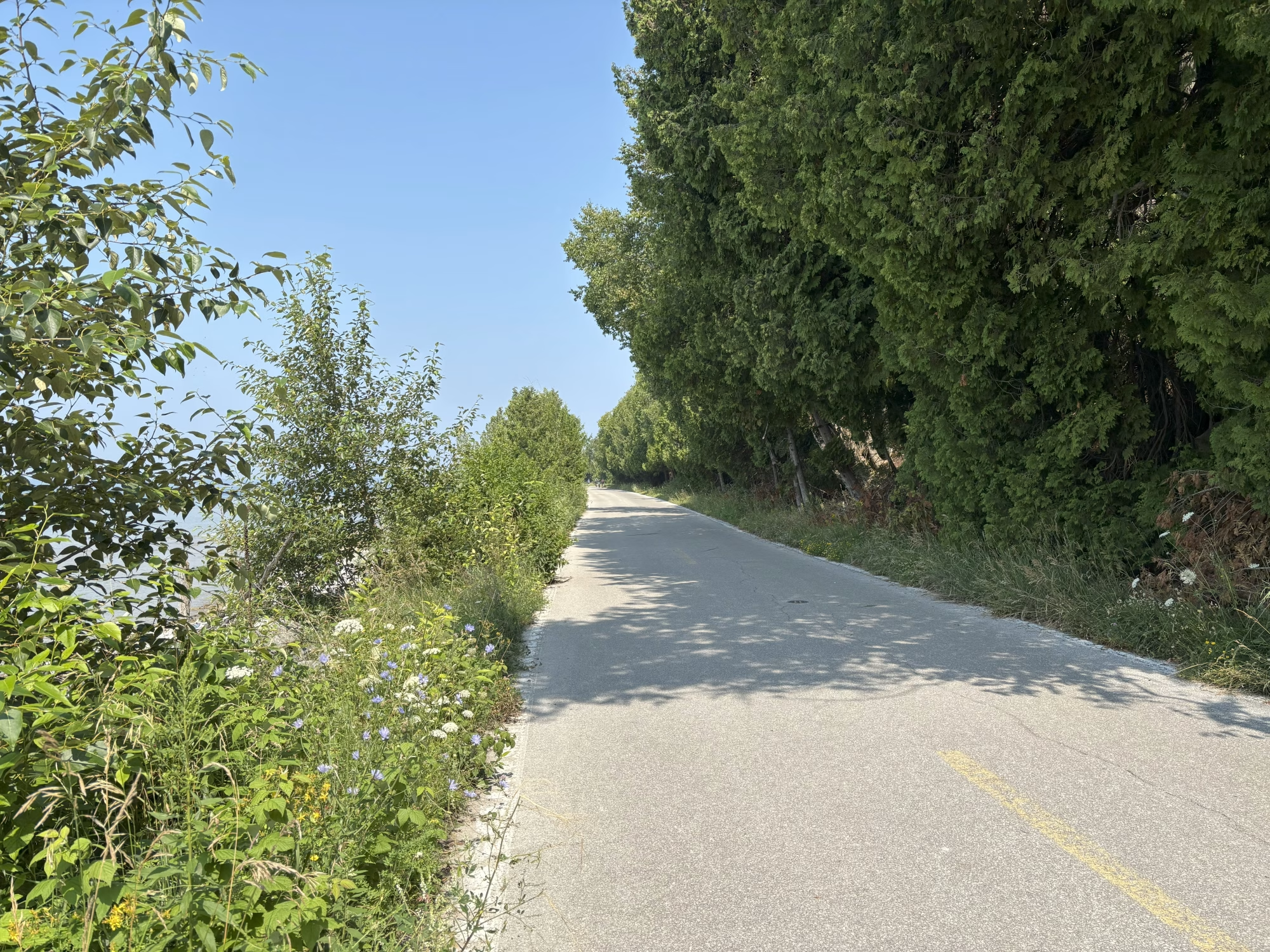
A Misplaced Clue Delays the Search
On the same morning Frances disappeared, a young couple was out for a bike ride around the island. Upon reaching the west side of the island, on Lake Shore Road, the pair noticed a purse lying in the roadway. In hopes of finding the purse’s owner and returning it, the couple peeked inside. The name on the ID read: Frances Lacey.
At this point, news of Frances’s disappearance had not spread throughout the island, and inside the bag, there was a flyer of sorts for the Chippewa Hotel. So, the couple decided to take the purse with them to Main Street, in hopes that returning it to the hotel would reunite the purse with its owner. Since Frances did not stay at the Chippewa, they would not take the bag. Instead, the couple decided to take the purse home to Detroit with them. Since Frances’ ID identified her hometown as Dearborn, the pair thought it might be easier to return it to her if she had already left Mackinac Island.
Locating this purse sooner would undoubtedly have sped up the search efforts, but the key piece of evidence was not revealed until news of Frances’s disappearance hit national news, four days later. Thus, the days after Frances’s disappearance and before her body was found were, expectedly, a confusing mix of hope and despair.
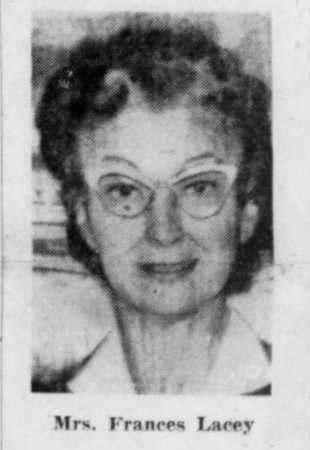
Hope, Speculation, and a Break in the Case
Her daughter, Kay, said during this time, “I’m going to stay on the Island as long as it takes to find her. I’ll do it even if it takes two years to find her and I have to become a beachcomber in the process.” While Frances was missing, there was speculation of an injury, suicide or amnesia, but the possibility of murder only crossed people’s minds fleetingly.
Futile early search efforts left investigators absolutely stumped as to why they could not locate Frances in what seemed to be a fairly small and navigable area. Finally, investigators caught a break. The couple who had found Frances’s purse on the morning of July 24th, after seeing her case on TV, called the Michigan State Police, detailing their findings and its location. On the evening of July 28th, 1960, this tip led police to Frances Lacey’s lifeless body, strangled to death by her own undergarments and nearly 50 feet in the woods off of Lake Shore Road. With evidence of sexual assault, the investigation harshly transitioned from finding a missing woman to locating a cold-blooded murderer and potential rapist.
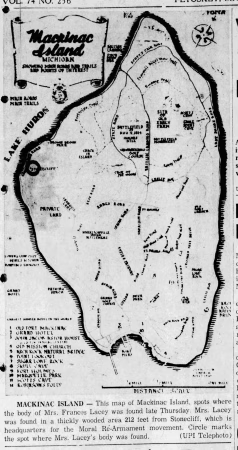
A Brutal Discovery and the FBI Steps In
At the crime scene, investigators found several strands of hair that did not match Frances’s, her broken dental plate, as well as the murder weapon, but they still lacked any solid leads. The FBI was swiftly brought in to aid in the investigation and lodged at the Hotel Iroquois during their investigation. The owner of the hotel at the time (and since 1954), Margaret McIntire, was asked in an interview from 2017, “Do you have any memories of the murder on Mackinac in 1960?”
She replied: “Yes I do. Mrs. Lacey, it was such a scary thing, because nothing like that had ever happened. There were a lot of people from the FBI and because [my husband] had been a State Police, they seemed to have a fraternity, anyway they all stayed with us, and all the FBI men booked in at the Iroquois. And then they required, in doing their investigation, they required that we supply them with information of where every single employee we had, where they were at the time when Mrs. Lacey died… It was a lot of work. These FBI men at night, they would come around the bar and so forth and it went on for a couple of weeks actually, because you know they found her body, but they weren’t getting any clues. And I knew some of the people they suspected, and it was a very, very difficult time”.
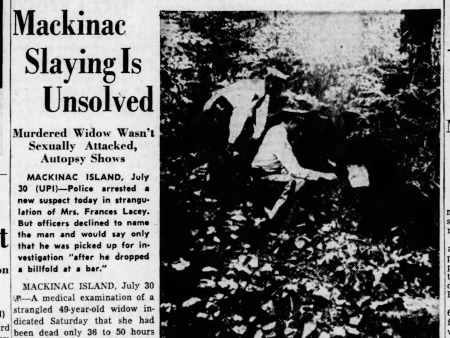
Investigation Narrows, But Suspects Slip Away
Summer employees were some of the few who police were certain were on the island the day of the murder, so it seemed like a solid starting point for their investigation. However, in four days, whether an island employee or visitor, the person responsible for Frances’s death could have traveled to an unlimited number of locations. The lack of evidence after discovering her body quickly supported this notion.
Unsolved Theories and Fading Leads
There are countless theories as to what happened to Frances Lacey that tragic Sunday morning, but still no answers. Notably, Frances’s watch was taken from her body. This detail has led some to suspect that a serial killer was responsible for her death, as many take trophies from their victims. However, in an article published in The Herald-Palladium, a small newspaper out of Benton Harbor, MI, on Saturday, July 30th, 1960, State Police Lt. Robert Bilgen indicated that, “[Police] have not been unable to develop any sort of link yet” between Frances’s death and other ongoing serial murder investigations. This theory was never eliminated, but there also hasn’t been any new evidence to support it.
Another theory suggests that the murderer may be an island summer resident. Upon investigating the island’s employees, a man named Paul Strandz was of particular suspicion for law enforcement. He was known to be a person who was always around; on the streets of Mackinac at random hours, and was already perceived as an odd person by the community. He allowed police to search his room with very little opposition, and in it they found several questionable items: lewd drawings of women, a crumpled-up newspaper article about how women should defend themselves, and what they thought to be blood stains on one of his shirts.
He was the only person ever arrested for the murder of Frances Lacey, but the blood stains turned out to be paint stains, he passed a polygraph test, and his alibi checked out. Police never found sufficient evidence to hold him, so he was released and was not considered again.
There was also speculation that Wesley Sutter could have been responsible due to a financial motive. Some island residents believed that Wesley might have been after an insurance payout, or that whoever was responsible was motivated by her large life insurance policy. These theories remain speculative and lack supporting evidence otherwise.
A Renewed Effort and Lost Evidence
In 2011, there was renewed police interest in the case, but in an incredibly disheartening turn, the unknown DNA collected from the scene was somehow lost, misplaced, or destroyed in the midst of the decades-long investigation. Despite all the advancements in forensics, the case now lacks DNA evidence to connect the responsible assailant.
A Historic Tragedy That Still Haunts the Island
In its centuries-long history, Mackinac Island had never encountered a murder until that of Frances Lacey. The case stumped detectives in its immediate aftermath and continues to this day. It is not impossible for Frances’ murder to be solved, but the transient nature of Mackinac Island, alongside the loss of integral evidence, has made it a case tougher than most to crack. Ultimately, answers about Frances’ murder might never surface, but it is reassuring that nothing as severe has occurred on Mackinac Island since. And as the 65th anniversary of Frances’ brutal murder approaches, the unanswered questions remind us that, regardless of how peaceful a place might appear, evil people reside anywhere.
Sources:
Haunts of Mackinac by Todd Clements
A Conversation with Maragaret McIntire by Bob Tagatz (provided by the Hotel Iroquois)
Grim Paradise by Rod Sadler
The Herald-Palladium, Isle Killing Runs Into Stone Wall
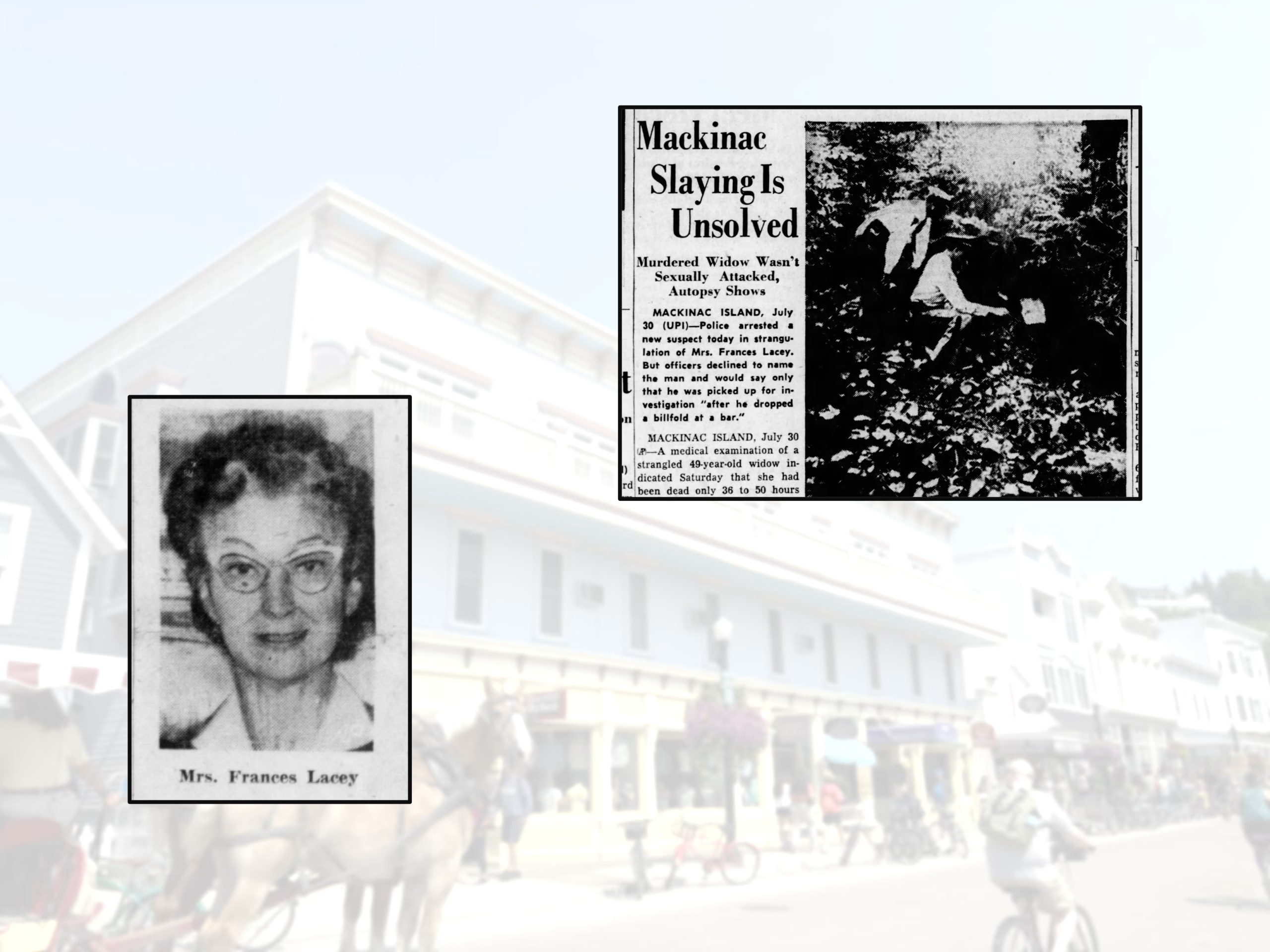


 8123 Main St Suite 200 Dexter, MI 48130
8123 Main St Suite 200 Dexter, MI 48130


